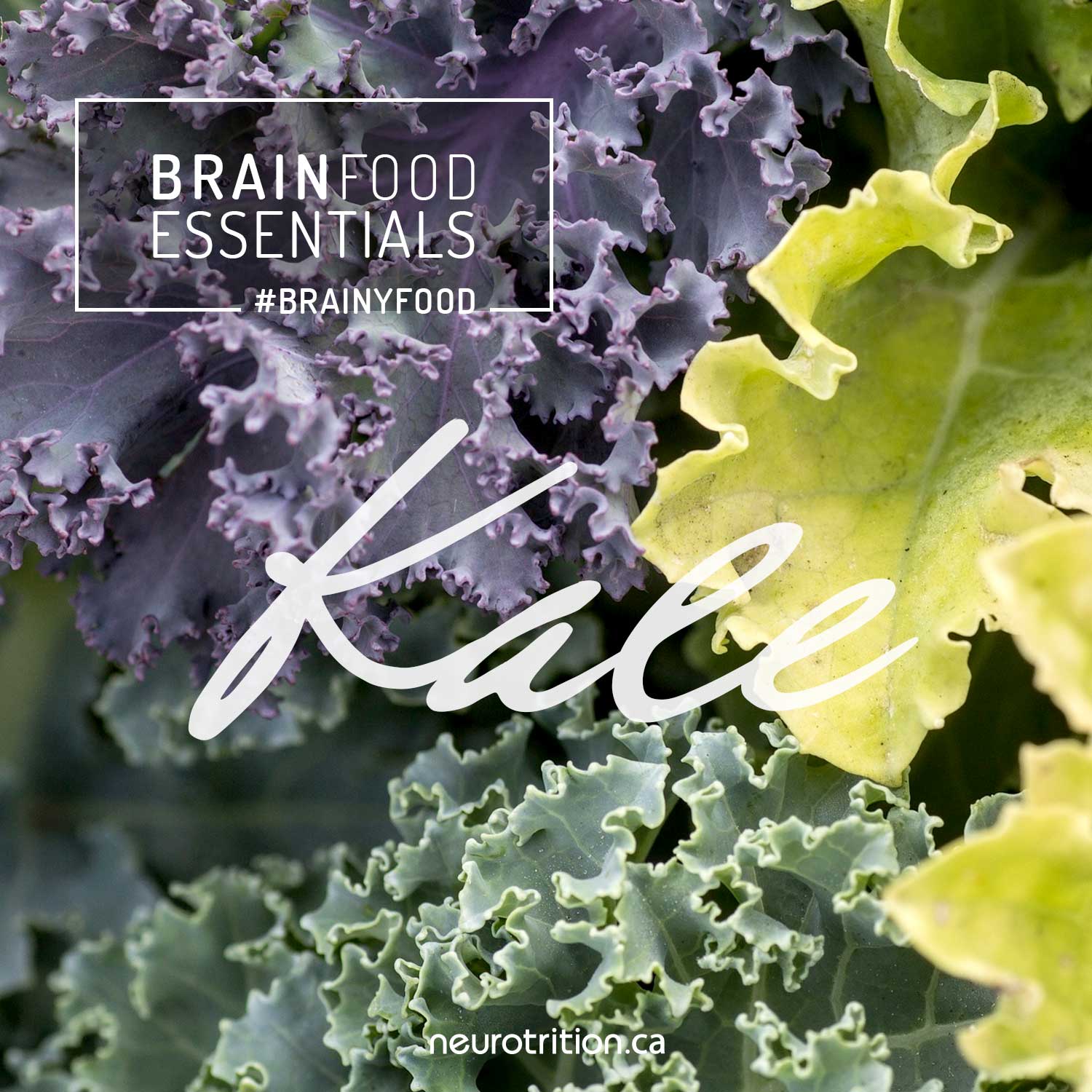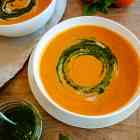Brain Food Essentials :: Kale

Does the saying “eat your greens” ring a bell?
It’s no myth – green leaves are very nutritious! This is true.
Out of all the green leaves (think: spinach, romaine, iceberg, etc.) kale is one of the best and one of my personal favourites. Kale has been on the IT list for some time now and is considered a “superfood.” And, I mean, I love kale, but I always want to go beyond the trends and fads to uncover whether a food actually lives up to the hype. Plus, trends (and kale) can get pricey so I always want to verify if a trend is legit. I dug into the research to see if kale truly lives up to its superstar status — especially from a NeuroTrition perspective.
Kale has more vitamins, minerals, and other nutrients than just about any other food.
What makes kale truly amazing is that it IS one of the most “nutrient dense” foods (this means that kale has one of the highest amounts of nutrition per calorie.) Kale has more vitamins, minerals, and other nutrients than just about any other food. It certainly does check out in the superfood designation department, thank goodness!
And, while all nutrient dense superfoods can help your overall health and wellness, I’m going to unpack how this particular superfood can help your overall neuro health and wellness.
KALE IS KING, HE NEEDS A MASSAGE
Show your kale a little love by giving it a culinary massage. De-stem your kale leaves, by pulling the leaf away from the central stem. Tear the leaves into pieces and use your hands to massage for 2-3 minutes. Or, you can add a good oil like extra virgin olive and get silky hands while you massage your kale. Massaging will soften the kale, improve its flavour and, because massaging acts like partial chewing, it will start to break down the cellulose in your kale. This effectively starts the digestion process, which takes a bit of stress off your digestive system, which means less gas and bloating.
HOW MUCH KALE DO I NEED TO EAT?
One cup of loosely packed raw kale contains heaps of vitamins and minerals. In fact, that one cup contains over 100% of your daily needs of vitamins A and K!
One cup of loosely packed raw kale contains heaps of vitamins and minerals. In fact, that one cup contains over 100% of your daily needs of vitamins A and K!
FUN FACTOID: Vitamins A and K are both fat-soluble. So to maximize absorption, please don’t eat your kale plain. Make sure you eat it along with some brain-healthy fat (like olive oil or avocado).
Kale is a great source of vitamin C. It also contains manganese, copper, magnesium (my fave anti-anxiety mineral), potassium, and vitamin B6 (my fave antidepressant vitamin). Not to mention, it’s packed with antioxidants, phytochemicals (phyto = plant), and fibre too.
All of that nutrition in just 8 calories! Just think how much nutrition you would get from two or three “loosely packed” cups of kale! I know, this sounds daunting but keep reading to see how you can do it without feeling like you’re eating a heaping mound of kale (which there is nothing wrong with!)
See what it means to be “nutrient dense?”
Let’s first go over what makes kale’s vitamins A and K brain nutrients. I find this science really cool and really relevant, given that we may be able to use kale as one tool in the fight against serious brain disease.
FUN FACTOID: Kale comes in a few different shapes, sizes, and colours. It can be many shades of green, or even purple.
KALE AS BRAIN FOOD
Kale contains a lot of pre-vitamin A called “beta-carotene,” which is an antioxidant. Our bodies transform beta-carotene (pre-vitamin A) into vitamin A and use it for a bunch of functions, including functions in our brain. And I’m particularly interested by vitamin A because it is starting to show some promise for 3 really big, bad brain diseases: Alzheimer’s, ALS and brain cancer.
Conventional kale is, unfortunately, on the Environmental Working Group’s Dirty Dozen list (www.ewg.org). If you’ve not heard of the Dirty Dozen list before, it refers to the 12 most pesticide-heavy fruits and vegetables (in contrast to their Clean 15 list, the least pesticide-laden 15 produce items). If possible, buy organic kale to reduce the likelihood of brain draining pesticides.
1. Vitamin A for Alzheimer’s Disease
One of the (many) brainy functions of vitamin A is in warding off Alzheimer’s disease. Higher blood levels of vitamin A are associated with better cognition (ability to think) in the elderly. And, low levels of vitamin A have been found in many people with Alzheimer’s disease. In rodents, vitamin A deficiency increases the amount of the bad Alzheimer’s proteins in the brain (that Alzheimer’s protein is called “amyloid-β peptide”).
2. Vitamin A for ALS
Another neuro-function of vitamin A is how it protects neurons. A recent study found that a compound from vitamin A protects nerve cells damaged by ALS (amyotrophic lateral sclerosis). This may be a future approach for people with the neurodegenerative disease, and it is a powerful example that helps to position food as medicine!
3. Vitamin A for brain cancer
Eating more vitamin A can also reduce your risk of the most common brain cancer, glioma. Talk about a brain-friendly nutrient!
FUN FACTOID: Vitamin A is an antioxidant that helps protect our cell membranes against oxidation and inflammation from dangerous free radicals. The antioxidant ability of kale is especially high when eaten raw.
Kale is also one of the best sources of VITAMIN K. One loosely packed cup has more that a whole day’s requirement! I love vitamin K because it’s shown to help two particularly dangerous and common neurological problems: stroke and dementia.
1. Vitamin K to prevent stroke
Vitamin K is known for its blood-clotting and bone health properties, but did you know it’s a neuro-vitamin too? That’s because, what’s good for your blood is also good for your brain. Vitamin K helps your blood to clot (in fact, bleeding can be a sign of vitamin K deficiency). And, your vitamin K levels (and your resulting blood-clotting function) are critical for warding off certain types of strokes.
2. Vitamin K for dementia
When it comes to dementia, just like vitamin A, vitamin K levels are low in people with Alzheimer’s disease, and are higher in people with better cognition.
FUN FACTOID: In addition to getting vitamin K from food, it is also made by some of our friendly gut microbes. Kale not only contains vitamin K, but also the special prebiotic fibre needed to feed these “gut bugs” that then make your vitamin K!
So, as you can see, kale IS a brain food essential!
5 EASY WAYS TO GET YOUR DOSE OF KALE
1. Salad, obviously
Buy a bunch of kale and wash and rip up the leaves for a salad that packs a serious nutritional punch. Or, substitute some of your regular salad greens for kale and add your favourite toppings (like roasted sweet potato, walnuts, or hemp seeds). Try topping it with sardines and drizzle some of your favourite healthy dressing on top. Or, why not try one of my all-time fave salads a la NeuroTrition: I give you our Kale Caesar Salad recipe, here.
2. Smoothies
Throw a handful of kale leaves into your favourite smoothie. You can easily turn a “non-green” smoothie green. Or even crank up your regular green smoothie a notch by substituting kale for your another leafy green. Have you tried our Blueberry Basil Smoothie yet? Try swapping the spinach for kale in this delicious recipe.
3. Snack Food
For a delicious snack, try kale chips. Yes, they are what they sound like. And they’re super-simple to make. Pre-heat your oven to 300ºF. Take one bunch of kale and wash, dry and rip up the kale leaves into bite-sized pieces. Place them on a cookie sheet and drizzle a tablespoon of olive oil onto them, massaging into the leaves. Then sprinkle with a bit of sea salt and garlic powder. Bake for 10 minutes. Then flip them over and put them back into the oven for 5 more minutes. Watch them to see when they start turning brown, and then remove them from the oven & let cool.
4. Brainy Bowls (or Balls)
How about the kale in this Roasted Wild Salmon & Quinoa recipe? Our Neuro-Chefs have created two different versions for you, including the cutest little kid-friendly version, here.
5. Soups & Stews (an afterthought)
Don’t forget to add some kale into your favourite soups and stews (this is a great way to use up that kale). Adding kale will definitely give your current recipes a nice nutritional punch, and great flavour and colour.
I’m happy to report that this trendy food does indeed check out (and then some!) in the research. You can feel all kinds of good about loading your diet up with kale, and I hope you do. I’m particularly (and obviously!) excited by the fact that the super high levels of vitamins A and K, found in kale, are showing promise for brain disorders like ALS, Alzheimers, brain cancer and stroke. This is one trendy food that is NeuroTrition Approved!
- References
-
- Conly, J.M., Stein, K., Worobetz, L. & Rutledge-Harding, S. (1994). The contribution of vitamin K2 (menaquinones) produced by the intestinal microflora to human nutritional requirements for vitamin K. The American Journal of Gastroenterology. 89(6), 915-23.
- Grimm, M.O.W., Mett, J., & Hartmann, T. (2016). The Impact of Vitamin E and Other Fat-Soluble Vitamins on Alzheimer´s Disease. International Journal of Molecular Sciences. 17(11), 1785.
- Health Canada, Dietary Reference Intakes. Reference Values for Elements.
- Health Canada, Dietary Reference Intakes. Reference Values for Vitamins.
- Kapusta-Duch, J., Kopeć, A., Piatkowska, E., Borczak, B. & Leszczyńska, T. (2012). The beneficial effects of Brassica vegetables on human health. Annals of National Institute of Hygiene. 63(4), 389-95.
- Lv, W., Zhong, X., Xu, L., & Han, W. (2015). Association between Dietary Vitamin A Intake and the Risk of Glioma: Evidence from a Meta-analysis. Nutrients. 7(11), 8897–8904.
- Migliozzi, M., Thavarajah, D., Thavarajah, P., & Smith, P. (2015). Lentil and Kale: Complementary Nutrient-Rich Whole Food Sources to Combat Micronutrient and Calorie Malnutrition. Nutrients. 7(11), 9285–9298.
- Reboul, E. (2013). Absorption of Vitamin A and Carotenoids by the Enterocyte: Focus on Transport Proteins. Nutrients. 5(9), 3563–3581.
- Riancho, J., Berciano, M.T., Ruiz-Soto, M., Berciano, J., Landreth, G. & Lafarga, M. (2016). Retinoids and motor neuron disease: Potential role in amyotrophic lateral sclerosis. J Neurol Sci. 360, 115-20.
- SELF Nutrition Data. Kale, raw.
- Sikora E. & Bodziarczyk, I. (2012). Composition and antioxidant activity of kale (Brassica oleracea L. var. acephala) raw and cooked. Acta scientiarum polonorum. Technologia alimentaria. 11(3), 239-48.
- Uematsu, T., Nagashima, S., Niwa, M., Kohno, K., Sassa, T., Ishii, M., Tomono, Y., Yamato, C. & Kanamaru, M. (1996). Effect of dietary fat content on oral bioavailability of menatetrenone in humans. J Pharm Sci. 85(9), 1012-6.
- USDA Food-Nutrient Database. Kale, raw.










